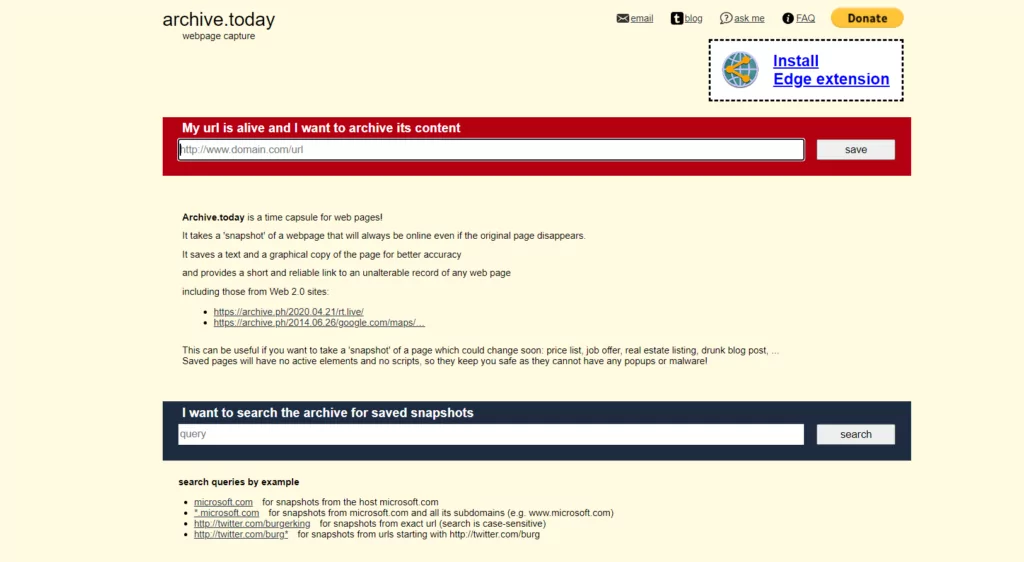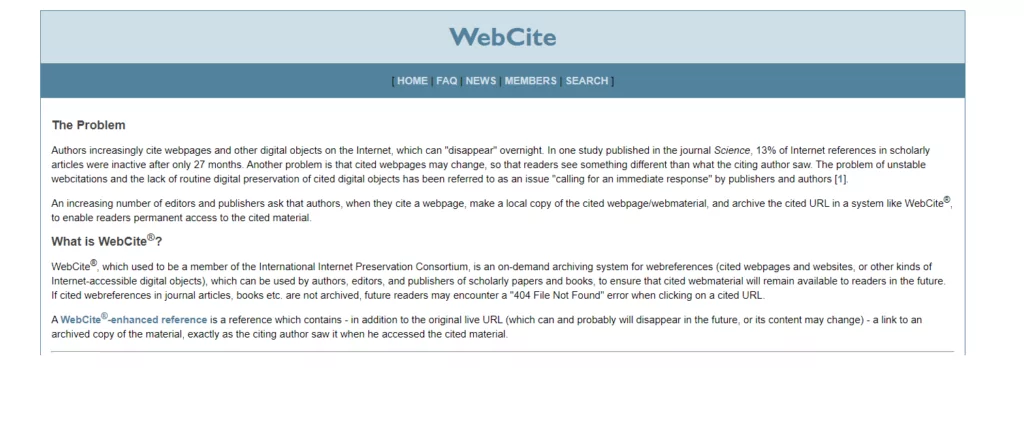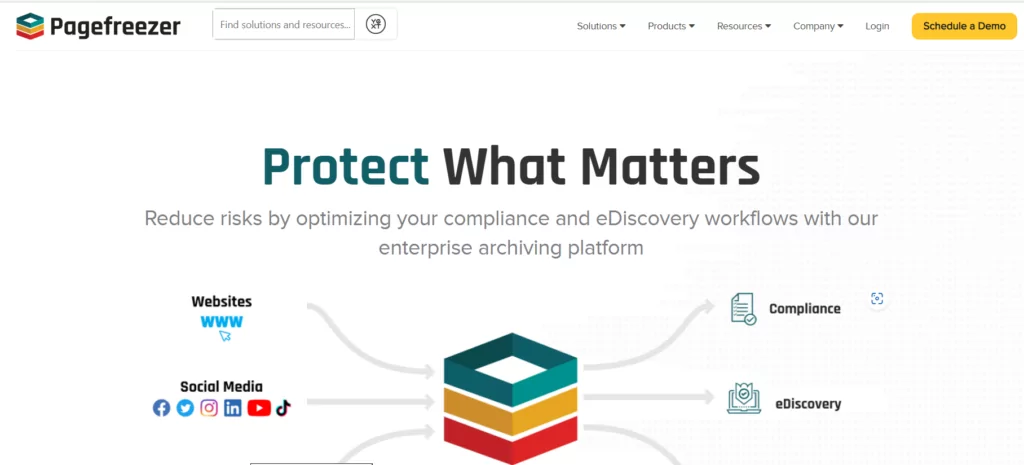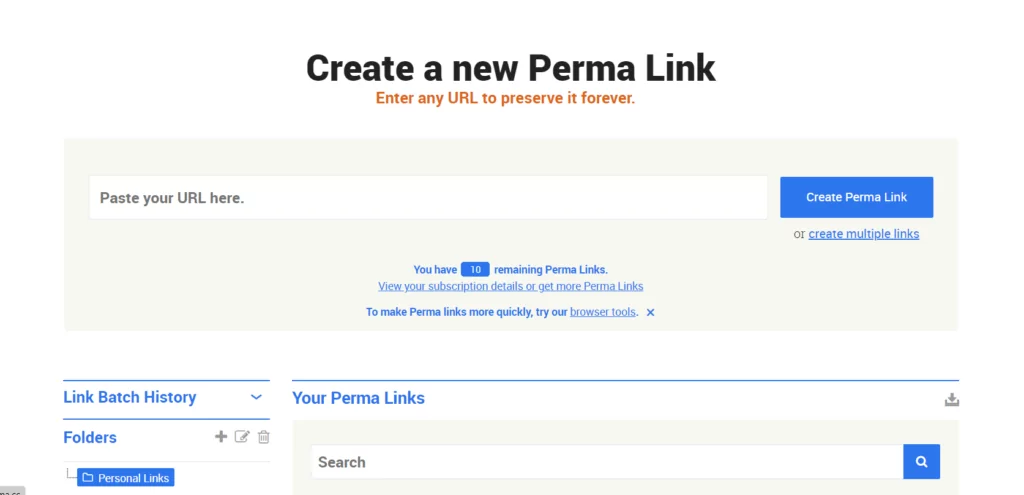Here are our top picks for the eight best Wayback Machine alternatives:
Best Wayback Machine Alternatives: Compared side by side
| Free | API | Archival Depth | Automatic Archiving | ||
|---|---|---|---|---|---|
| PageFreezer | No | Yes | Deep | Yes | |
| Archive.today | Yes | No | Shallow | No | |
| Perma.cc | No | Yes | Shallow | No | |
| Stillio | No | Yes | Shallow | Yes | |
| MirrorWeb | No | Yes | Deep | Yes | |
| WebCite | Yes | No | Shallow | No | |
| Ressurect Pages | Yes | No | Shallow | No | |
| Memento Time Travel | Yes | Yes | Depends | No |
What if you had an internet time machine? A history book of the world wide web? Enter web archiving.
Web archiving is the act of preserving digital content, and website history, maintaining historical records, and categorizing website information.
When it comes to web archiving, we’ve grown to appreciate the time-traveling functionality of Wayback Machine. But if you’re looking for more features than archive.org provides, we explore the best alternatives to the Wayback Machine here.
What is Web Archiving?
Web archiving refers to the process of collecting and storing web content for long-term preservation and access. It involves crawling and capturing web pages, websites, or entire web domains and creating a permanent record. The purpose is to preserve digital information that is vulnerable to loss or modification over time.
Archiving is typically carried out by specialized organizations, such as national libraries, archives, or dedicated institutions that use web crawlers or bots to systematically browse the web, capture web pages, and store them in an archive.
The archive content is stored in a specific file format, such as WARC (Web ARChive), which includes the web page’s text, images, and other files. These archives can then be accessed through an API or search engine.
Web Archiving Uses
Web archiving serves a variety of purposes and has numerous use cases across different fields. Here is a list of common uses:
- Historical Research: study the evolution of websites, track changes over time, and analyze digital content as a historical record.
- Preservation of Cultural Heritage: preserve the digital cultural heritage of society by capturing and storing websites and online content that may be lost or altered over time.
- Academic Studies: use archive sites as a valuable resource for studying social, political, and cultural phenomena, conducting data analysis, and examining web-based interactions.
- Journalism and Media Analysis: retrieve and verify information from past versions of websites, fact-check articles, and analyze changes in news coverage over time.
- Legal and Regulatory Compliance: preserve evidence for legal proceedings, maintain compliance with regulatory requirements, and document the online presence of organizations.
- Digital Preservation: ensure long-term accessibility of digital content, including websites, blogs, social media posts, and other online resources.
- Government Accountability: hold public institutions accountable by capturing and preserving government websites, official documents, and public records for future reference.
- Business Records and Marketing Analysis: preserve your web presence, use it for analysis, and track changes in marketing campaigns, branding, SEO strategies, and SEO rankings. You can also track your competitor’s websites to analyze their success.
- Education and Teaching Resources: Web archives provide educators and students with access to historical web content, facilitating research, teaching digital literacy, and examining the evolution of online platforms.
- Nostalgia and Personal Archiving: Individuals use web archiving to capture and preserve web pages and content that hold personal significance or evoke nostalgia, such as personal blogs, social media profiles, or online communities.
How does Web Archiving Work?
Here is a simplified overview of how web archiving typically works:
Selection: Web archiving organizations determine which websites or web pages should be included in their archival collection. This can range from specific websites of historical or cultural importance to broader captures of entire web domains.
Crawling: Web crawlers, also known as bots or spiders, are used to navigate the web and discover web pages. These crawlers follow links from one webpage to another, building a comprehensive network of URLs to capture.
Capture: Once the web crawler identifies a web page to capture, it initiates the capture process. The crawler requests the web page from the server and retrieves the HTML code, along with associated files such as images, CSS, JavaScript, and other resources. The crawler can also take screenshots or capture other metadata about a page, including WHOis information.
Storage: The page and its associated files are stored in a web archive repository. The repository uses a specialized file format like WARC (Web ARChive) to encapsulate and preserve the content. WARC files can contain the full text, images, metadata, and other resources needed to reconstruct the captured web page.
Indexing and Metadata: To facilitate search and retrieval, web archiving services create indexes and metadata for the archived content. This includes capturing information such as the URL, date and time of capture, and other descriptive data that aids in organizing and searching the archive.
Access and Retrieval: Archived web content is made available to users through web archive services. Users can search, browse, and access the archived web pages using various search interfaces provided by the web archiving organization. Users can view the captured web pages in their original form, including text, images, and other embedded resources.
Periodic Updates: You can revisit previously archived websites or web pages to capture subsequent changes and updates. This helps in maintaining a comprehensive historical record of the evolving web.
What makes the Wayback Machine so Popular?
The Wayback Machine’s popularity is driven by its mission to preserve the web’s history, its user-friendly interface, its extensive archive, and its accessibility to the public. It has become a go-to resource for exploring the evolution of the web and accessing information that would otherwise be lost or altered.
However, if you’re looking for more options for whatever reason, here are the top Wayback Machine alternatives.
Top Alternatives to the Wayback Machine
1. Archive.Today

Best for: archiving and snapshotting an individual web page.
Archive.today (previously known as Archive.is) is a good alternative to the Wayback Machine. This free internet archive website and archiving service allow users to capture and store snapshots of web pages. It works by saving a copy of a webpage at a particular point in time, including its HTML, images, and other media files, and creating a unique URL for that snapshot.
Unlike the way back machine, Archive.today focuses more on individual snapshots of web pages rather than the extensive archival coverage provided by the Wayback Machine.
Top Features & Pros
- Snapshot Preservation: Archive.today allows you to capture and preserve specific web pages, ensuring their availability even if the original page is modified, deleted, or experiences link rot.
- User Control: Users can manually submit URLs to Archive.today, giving them control over which pages they want to preserve and access in the future.
- Privacy: Archive.today offers an option to save web pages anonymously, protecting the user’s privacy if desired.
- Direct Access: Each archived page on Archive.today receives a unique URL, making it easy to share and access the preserved snapshot directly.
- Capturing Dynamic Content: Archive.today is capable of capturing web pages with interactive or dynamic elements, including media files, JavaScript, and CSS.
Cons
- Limited Coverage: Archive.today’s focus is on individual snapshots submitted by users, which means it may not have as extensive coverage as the Wayback Machine, which aims to archive the entire web.
- Snapshot Quality: Since Archive.today relies on user submissions, the quality and completeness of the captured snapshots can vary. Some pages may not be fully archived or may have missing elements.
- Limited Searchability: Unlike the Wayback Machine, Archive.today does not provide a robust search interface to explore its archive. It primarily relies on direct URL access rather than comprehensive browsing or indexing features.
- Dependency on User Submissions: Archive.today relies on users actively submitting URLs for archiving. If a webpage is not submitted or missed by users, it may not be preserved in the archive.
- Lack of Versioning: Unlike the Wayback Machine, which stores multiple versions of web pages over time, Archive.today primarily focuses on preserving a single snapshot of a page, limiting the ability to track changes or view historical variations.
Archive Depth
The specific archive depth setting is not publicly disclosed. Archive.today saves a snapshot of a page at the time of submission but it does not automatically crawl and capture other pages linked from the submitted page.
Pricing
Archive.today is completely free to use.
2. Webcite

Webcite focuses on preserving cited web pages for long-term access to scholarly content. It offers a specialized solution for capturing and archiving web pages referenced in academic papers and letting researchers maintain accurate citations and access the cited content even if it changes or disappears from the live web. It’s important to note that, as of 6/28/2023, they are not accepting additional archive requests.
Top Features & Pros
- Citation Preservation: Webcite excels at preserving cited web pages and ensuring their availability for scholarly purposes. Researchers can confidently reference web content, knowing that it will be archived and accessible for future reference.
- Archival Depth: While the exact archive depth is not specified, Webcite generally provides comprehensive coverage of the web pages that are cited in academic papers. It aims to capture and preserve the full content of referenced web pages, including text, images, and other media.
- Citation Formatting: Webcite offers tools and features to assist researchers in formatting citations correctly. It provides citation metadata and generates citation links that can be included in academic papers, improving the accuracy and reliability of references.
Cons
- Limited Features: Webcite’s focus on citation preservation means that it may lack some of the advanced features and functionalities offered by more comprehensive web archiving services. It may not be suitable for those seeking broader web capture or in-depth archiving of entire websites.
- Limited Customizability: As a free service, Webcite may have limitations in terms of customization and control over archival settings. Users may not have extensive options for adjusting the archival depth, crawl frequency, or other parameters to tailor the archiving process to their specific needs.
Archival Depth
Webcite aims to capture and preserve the specific web pages that are cited in academic papers. Its archival depth focuses on the targeted pages referenced by researchers rather than comprehensive website archiving. It ensures that the cited content is saved and accessible for future reference.
Pricing
Webcite is available as a free service for individual researchers. While pricing for institutional or enterprise use is not explicitly stated, it is advisable to contact Webcite directly to inquire about pricing options for organizations or larger-scale usage.
3. Pagefreezer

Best for: capturing social media content
Pagefreezer helps organizations that require robust compliance and eDiscovery and litigation readiness. It offers a range of features for capturing, storing, and retrieving website and social media content, making it a valuable solution for industries such as finance, healthcare, government, and legal sectors.
Top Features & Pros
- Comprehensive Archiving: Pagefreezer excels in capturing and preserving a website and social media content. It ensures that every element, including web pages, posts, comments, images, and videos, is archived in its original form, providing a comprehensive and accurate record of online activities.
- Compliance and eDiscovery Support: Pagefreezer offers specialized features to meet regulatory compliance requirements and support eDiscovery processes. It facilitates the secure storage, searchability, and exportability of archived content, making it easier for organizations to respond to legal requests or regulatory audits.
- Data Export Options: Pagefreezer provides various data export options, allowing users to extract archived content in a format that suits their needs. This flexibility is beneficial for legal teams, auditors, or researchers who require offline access to archived data.
Cons
- Lack of Free Trial: Pagefreezer does not publicly advertise a free trial option. Potential users may need to reach out to the Pagefreezer team directly to inquire about trial availability, which could be a drawback for those who prefer to test the service before committing to a subscription.
Archival Depth
Pagefreezer provides robust archival depth, capturing a comprehensive snapshot of websites and social media platforms. It aims to capture all pages, posts, and associated content within the specified archiving scope.
Pricing
Pagefreezer offers custom pricing based on the individual needs and requirements of each organization. The pricing is determined after considering factors such as the scope of archiving, the volume of data to be captured, and the desired retention period.
4. Perma.cc

Best for: researchers, academics, legal professionals, and anyone who needs to preserve and reference web pages for long-term access and citation purposes.
Did you know that around 50% of links cited in supreme court cases don’t exist? Perma.cc addresses the issue of link rot, which occurs when web pages become unavailable or their content changes over time. With perma.cc, you can simply paste in the link you want to preserve and get a permanent archive snapshot.
Top Features & Pros
- Reliable Preservation: Perma.cc excels in preserving web pages as they appeared at the time of archiving. It captures the content and associated files, creating a reliable and authentic snapshot of the page.
- Persistent URLs: Perma.cc assigns unique, persistent URLs (PURLs) to each archived web page. These PURLs remain accessible over time, even if the original URL becomes broken or changes.
- Browser Extension. You can archive pages from anywhere with the perma.cc browser extension.
- API. Perma.CC allows you to generate an API key and leverage their flexible archiving services to retrieve, create, or download archives.
- Collaboration Features: Perma.cc allows users to collaborate on archiving efforts by creating organizational accounts, enabling multiple users to contribute and manage archived content.
Cons
- No Free Version: Perma.cc does not offer a free version. It requires a subscription or payment for access to its archiving services and features.
- Reliance on External Archiving: Perma.cc relies on external web archives, such as the Internet Archive, to store the archived content. This dependence on external services may introduce some uncertainties regarding long-term preservation and access.
Archival Depth
Perma.cc’s archival depth is shallow, focusing on capturing individual web pages rather than extensive website archiving. While it excels at preserving the specific pages users submit, so it doesn’t automatically crawl and capture linked pages or perform broader web crawling.
Pricing
Perma.cc has different pricing based on your intended purpose. For academics, the service is free. However, if you’re using perma.cc for personal use, they provide a few subscription options.
- 10 Links/ @ $10/mo
- 100 Links/mo @ $25/mo
- 500 Links/mo @ $50/mo
5. Stillio

Best for: comprehensive site and communication monitoring
Stillio is one of the most comprehensive platforms on this list. Since it’s a paid service, they provide a more user-friendly experience than some of the free alternatives.
Top Features & Pros
- Automated Screenshot Capture: Stillio allows users to schedule automated captures of web pages at specified intervals. This feature eliminates the need for manual screenshots and ensures regular and consistent archival of web page visuals.
- Customizable Capture Parameters: Users have control over various capture settings, including capture frequency, capture region (full page or specific area), and capture resolution. It’s flexible enough to be tailored to your needs.
- Automatic Scheduled Captures: With Stillio’s archiving tool, you can set a schedule to automatically capture your websites at particular points in time. No matter the frequency, Stillio can take real-time snapshots monthly, weekly, and even hourly.
- Email notifications. When a new screenshot is captured, you’ll receive an email alert with a low-resolution version of the image and a link to download it.
- Cloud-Based Storage and Access: Captured screenshots are securely stored in the cloud, allowing users to access and view them at any time through the Stillio platform.
- Integrations: One of the cool things that separate Stillio from the other members of the list is its support for integrations. For example, you can use Zapier to sync screenshots to Slack, AWS or Box.
- API: You can use the Stillio API for interacting with the webpages and screenshots.
Cons
- No Annual Plan. Reviewers with different budget requirements would like to see payment options for annual plans.
- Lack of Metadata: Stillio primarily captures screenshots without extensive metadata about the captured web pages. While it provides basic information like the date and time of capture, more detailed metadata such as URL, title, or description may not be available.
Archival Depth
The digital archive depth of Stillio is shallow since it focuses on capturing screenshots of individual web pages rather than exploring and capturing linked pages or dynamic content within websites.
Pricing
Stillio offers multiple pricing plans based on the number of screenshots and the frequency of captures.
- Snap Shot – $29/mo. Includes tracking up to 5 web pages as well as daily, weekly, or monthly scheduling.
- Hot Shot – $79/mo. Tracks up to 25 different web pages.
- Big Shot – $199/mo. Tracks up to 100 different web pages.
- Top Shot – $299/mo. Tracks any number of web pages and supports scheduled snapshots up to every 5 minutes.
6. Resurrect Pages
Best for: Resurrect Pages is best suited for users who frequently encounter dead or inaccessible web pages while conducting online research, fact-checking, or accessing archived content.
Resurrect Pages is a browser extension designed to help users access web content that has been removed, deleted, or made inaccessible. It provides a handy solution for anyone seeking to retrieve lost information from expired web pages.
Top Features & Pros
- Effortless Accessibility: The extension seamlessly integrates into popular browsers, including Chrome and Firefox, enabling users to access its functionality with ease.
- Multiple Archive Options: Resurrect Pages offers various archive sources, such as the Wayback Machine, Google Cache, and CoralCDN, increasing the likelihood of retrieving missing web content.
- Intuitive User Interface: The extension’s simple and intuitive interface allows users to initiate the resurrection process with a single click, providing a hassle-free experience.
- Customizable Shortcut Keys: Users can configure personalized shortcut keys for quick access and convenience, streamlining the retrieval process.
Cons
- Limited Success Guarantee: Due to the nature of web archiving and content removal, Resurrect Pages cannot guarantee that all missing content will be successfully retrieved.
- Dependency on External Archives: The effectiveness of Resurrect Pages heavily relies on the availability and coverage of external web archiving services, which may vary depending on the specific page or website.
Archival Depth
Resurrect Pages primarily rely on external web archiving services, such as the Wayback Machine, to retrieve and display archived versions of web pages. The archival depth, therefore, depends on the archive sources used. While the Wayback Machine has extensive coverage, there may be cases where archived versions are unavailable or incomplete.
Pricing
Resurrect Pages is available as a free browser extension, and there are no direct costs associated with its usage. Users can download and install the extension from the respective browser’s extension marketplace without incurring any charges.
7. Memento Time Travel

Memento is a protocol and framework for accessing web resources from the past. It allows users to access archived versions of web pages as they appeared at a specific point in time, enabling them to view websites and web content as they existed in the past.
Top Features & Pros
- Time-Based Browsing: Memento Time Travel excels in providing a seamless experience for navigating through archived web pages based on specific dates. Users can easily explore how a website appeared at different points in history, aiding in research and analysis.
- Memento Protocol Support: By adhering to the Memento protocol, Memento Time Travel ensures compatibility with a wide range of web archives that support the protocol. This expands the scope of accessible archived content and enhances its usefulness for users.
- Access to Multiple Web Archives: Memento Time Travel allows users to access and search across various web archives from a single interface. This convenient access to multiple archival collections enhances the breadth and depth of the historical web content available.
Cons
- Dependency on Memento Protocol Support: The effectiveness of Memento Time Travel relies on the support for the Memento protocol. If a specific archive does not implement or support the protocol, accessing archived versions from that archive may be limited or unavailable.
- Limited Archival Depth: Memento Time Travel does not control the depth of archiving for individual websites or domains. The archival depth is determined by the service itself, and not all archives capture and preserve web content to the same extent.
Archival Depth
The archival depth of Memento Time Travel is reliant on the archives that support the Memento protocol. Each archive has its own policies and strategies for capturing and preserving web pages.
Pricing
Memento Time Travel itself is a free service, allowing users to explore the archived versions of websites without any cost. However, it’s important to note that accessing some web archives through Memento Time Travel may require separate subscriptions or fees.
8. MirrorWeb

Best for: MirrorWeb is best suited for finance, government, healthcare, legal, and media, where regulatory compliance and information governance are critical.
MirrorWeb offers comprehensive and unified communication surveillance. Beyond website archival, it also supports mobile communication archiving like SMS, WhatsApp, and WeChat in addition to email and social media archival.
Top Features & Pros
- Compliance Focus: MirrorWeb prioritizes regulatory compliance and adheres to industry standards, making it suitable for organizations with strict legal and compliance requirements.
- Scalable Archiving: It offers scalable archiving capabilities, allowing organizations to capture and preserve vast amounts of web content over time.
- Advanced Search and Retrieval: MirrorWeb provides powerful search functionality, enabling users to efficiently search and retrieve archived web pages using keywords and filters.
- Data Integrity: The platform ensures the integrity of archived content through checksum verification, maintaining the accuracy and authenticity of the captured web pages.
- Website Replays: MirrorWeb offers interactive replay functionality, allowing users to experience archived websites in their original form, including dynamic content and interactivity.
Cons
- Complex Implementation: Implementing MirrorWeb may require technical expertise and involvement from the organization’s IT or web development teams.
- Limited Public Access: MirrorWeb primarily focuses on private archiving for organizations, so public access to archived content may be restricted.
Archival Depth
MirrorWeb provides flexible archival depth, allowing organizations to specify the desired depth of capture during the archiving process. The exact archive depth can be customized based on the organization’s requirements, including capturing specific web pages, sections, or entire websites.
Pricing
MirrorWeb offers three subscription services. However, the pricing is consultative and is not openly available on their website.
- Insight Starter
- Insight Stack
- Insight Enterprise
FAQs
Is there a better website than Wayback Machine?
While the Wayback Machine is widely recognized and popular for web archiving, there are other notable alternatives available. Check out the available alternatives in this article.
What is the best search engine for old websites?
When searching for old websites, the Wayback Machine itself is an excellent search engine as it indexes and provides access to its extensive web archive. It allows users to search for specific websites or URLs and browse archived versions from different dates.
Is Wayback Machine still working?
As of today Wayback Machine, or archive.org is still operational and actively archiving web pages. It continues to capture and store web content for future reference.
What are some other ways to search for old websites?
Besides the Wayback Machine, there are a few other ways to search for old websites. Some search engines like Google have options to view cached versions of web pages by clicking on the “Cached” link in search results. Additionally, theweb archiving services on this list like Archive.today and Memento project have their own search capabilities to access their respective web archives.
What are the best ways to archive websites?
Besides relying on specific web archiving services, there are a few methods to archive websites. One approach is to use web archiving software like HTTrack or Wget, which allow users to download and store web pages for offline access. Additionally, some content management systems (CMS) provide archiving capabilities, enabling website owners to save and preserve previous versions of their sites. Organizations may also consider partnering with web archiving institutions or national libraries for comprehensive and professional archiving solutions.

Grant is a Solution Architect and SaaS product reviewer. His work concentrates solely on SaaS and technology, collaborating with clients in DevOps, Testing, Endpoint management, and cloud hosting.







